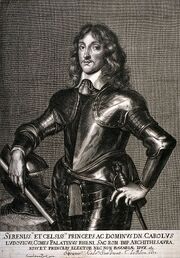| ||||||||||||||||||||||||||||||||
Charles Louis, (German: Karl I. Ludwig), Elector Palatine KG (22 December 1617 – 28 August 1680) was the second son of Frederick V of the Palatinate, the "Winter King" of Bohemia, and his wife, Princess Elizabeth, daughter of King James I of England (James VI of Scotland).
After the death of his older brother in 1629, and of his father in 1632, Charles Louis inherited his exiled father's possessions in the Electorate of the Palatinate.
In 1648, as part of the Peace of Westphalia, he was restored to the Lower Palatinate and was made an Elector of the Holy Roman Empire, an eighth vote having been added.
Karl Ludwig in 1632[]
Note: In the series, he is consistently referred to as Karl Ludwig.
Along with the rest of his family, Karl Ludwig was taken captive when Cardinal-Infante Ferdinand seized most of the Netherlands after the destruction of the Dutch fleet by the League of Ostend.
Gustavus Adolphus recognized him as his father's heir, at least within the Upper and Lower Palatinate. Ernst of Saxe-Weimar's administration in the Upper Palatinate was, at least nominally, as regent for him. It does not appear that a similar arrangement was made for the Lower Palatinate, and it is implied that the Lower Palatinate was divided between at least two USE provinces at the Congress of Copenhagen.[1][n 1]
As the oldest nephew of King Charles, he was high in the line of succession to the throne of England. This caused him to figure in the plans of English exiles, such as Thomas Wentworth, who sought to depose Charles. While they did not have a particularly high opinion of Karl Ludwig, they still saw him as their best chance to replace Charles. However, sometime in late 1635, Karl Ludwig converted to Catholicism.[2]. By doing this, he effectively removed himself from succession, as the English people would not accept a Catholic king no matter how unpopular Charles and Richard Boyle might have become.
Notes[]
- ↑ As of early 1636, there is no indication that Karl Ludwig has made any attempt to claim any of his German lands, or that he has either expressed or denied any interest in claiming them.
References[]
- ↑ 1634: The Baltic War, ch. 68
- ↑ Grantville Gazette VI (paper), "The Masque". No dates are given, and Wentworth and his co-conspirators learning of the conversion is the first indication that it had happened. However, "Snared by a Good Book", in Grantville Gazette 43, is dated November 22, 1635 and mentions a current newspaper report about the attack described in "The Masque".
